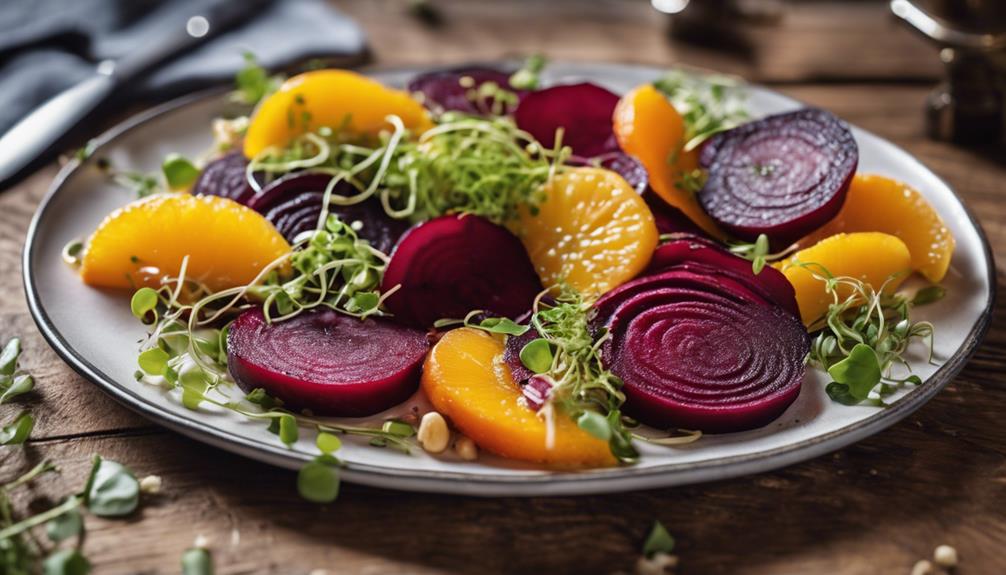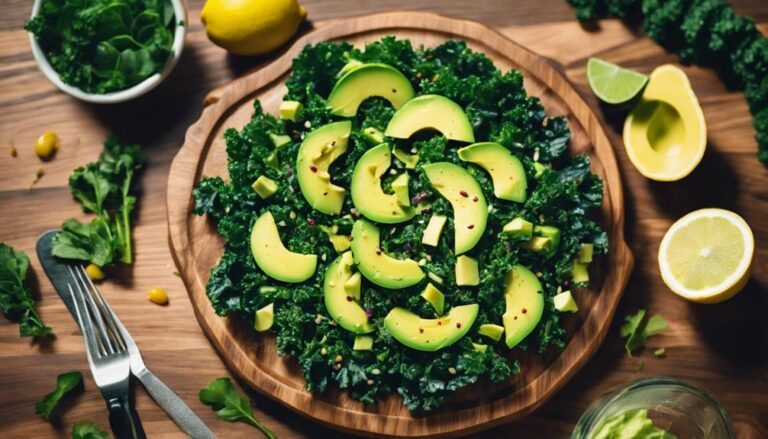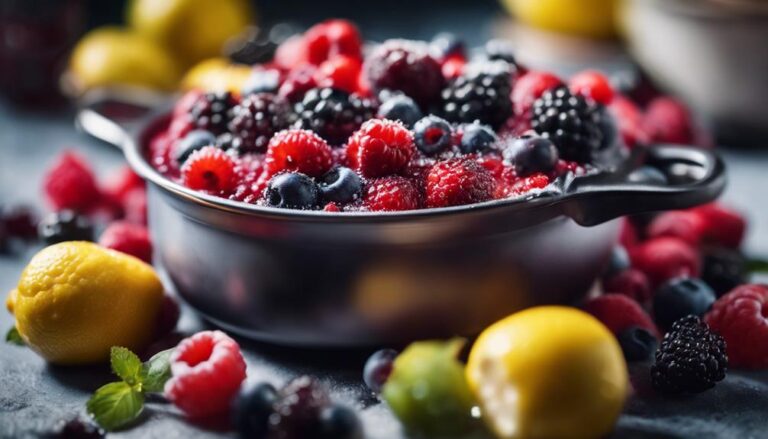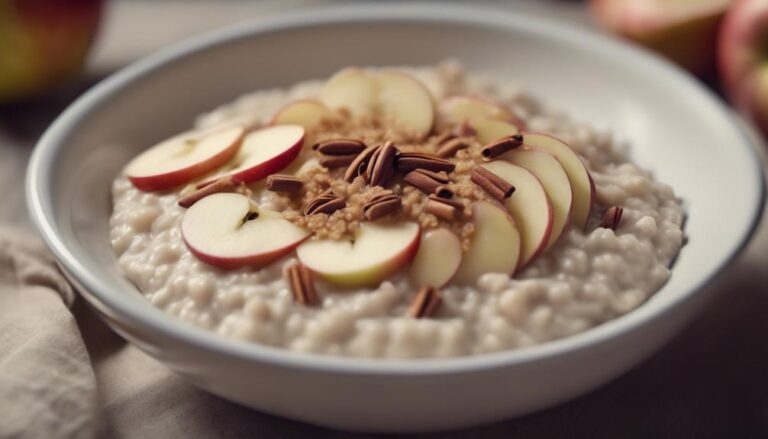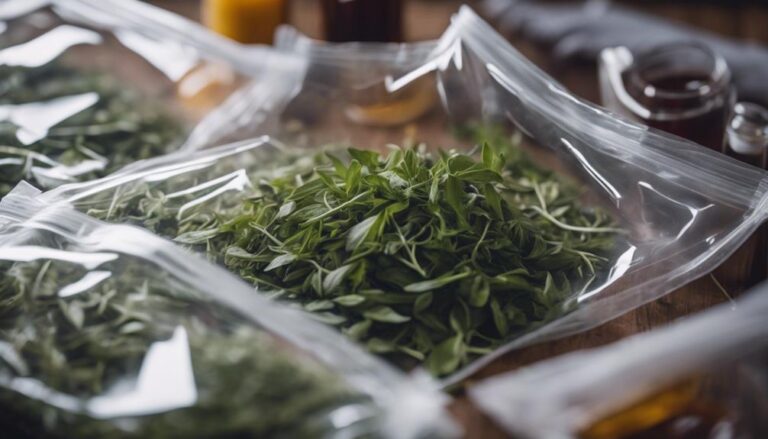Sous Vide Beet and Citrus Salad
Immerse beets in a sous vide bath for a tender, flavor-packed twist on your salad. Seal beets with citrus slices, herbs, and seasonings for an infusion of taste. Precision is key: set time and temperature for best cooking. The sous vide technique guarantees nutrients and flavors are locked in. The fusion of earthy beets and tangy citrus will tantalize your taste buds. Want to uncover more tips and variations for your next culinary adventure?
What You Will Learn Here
- Sous vide cooking enhances beet flavor and texture.
- Citrus adds brightness and acidity to the salad.
- Infuse herbs for a fragrant and flavorful profile.
- Achieve precise cooking with sous vide techniques.
- Experiment with citrus variations for unique taste combinations.
Beet's Ancient Culinary Roots

Beets hold a rich history in culinary traditions, dating back to ancient times. They've been valued for their versatility in various cuisines worldwide.
Additionally, beets are known for their impressive health benefits, making them a valuable addition to a balanced diet.
Beet's Historical Significance
Having been cultivated for centuries, the beet holds a significant place in culinary history for its ancient roots in various cuisines around the world. The beet's historical significance goes beyond its culinary uses; it also carries cultural symbolism and nutritional value. In ancient times, the beet was revered for its ability to provide sustenance and its medicinal properties.
Culturally, beets have symbolized diverse meanings across civilizations. In many cultures, the beet's deep red color represented love, vitality, and prosperity. Its earthy flavor and vibrant hue made it a staple in traditional dishes, symbolizing abundance and good fortune.
Nutritionally, beets are a powerhouse of vitamins and minerals. They're rich in antioxidants, fiber, and essential nutrients like folate and potassium. Ancient civilizations recognized the health benefits of beets, using them not only in culinary dishes but also in natural remedies to promote well-being.
Understanding the historical significance of beets sheds light on their enduring presence in global cuisine and the appreciation for their cultural symbolism and nutritional contributions.
Culinary Uses of Beets
Culinary history has seen beets play a pivotal role, with their ancient roots intertwined in a tapestry of diverse cuisines worldwide. Beets, with their earthy sweetness, have been used in various culinary traditions for centuries. In more recent times, chefs have explored innovative ways to incorporate beets into modern dishes, including desserts and cocktails.
Beet desserts have gained popularity for their unique flavor profile and vibrant color. From beet-infused cakes to beet sorbets, these desserts offer a delightful twist on traditional sweet treats. The natural sweetness of beets adds a subtle complexity that elevates the dessert experience.
In the domain of mixology, beet cocktails have emerged as a trendy choice for those seeking adventurous flavors. Beet juice can be used to create colorful and invigorating cocktails, adding a hint of sweetness and earthiness to the drink. Whether in a martini or a mocktail, beet cocktails offer a creative spin on classic beverages.
Beet's Health Benefits
With its ancient culinary roots, beet's health benefits have long been recognized for their nutritional value and medicinal properties. Beets are packed with essential nutrients like folate, potassium, and fiber, making them a powerhouse of health benefits. These vibrant root vegetables are known to support heart health, regulate blood pressure, and boost immunity. Additionally, beets contain nitrates that may improve athletic performance by enhancing endurance and reducing oxygen consumption during exercise.
When it comes to cooking methods, beets can be enjoyed in various ways to maximize their nutritional benefits. Roasting beets helps to enhance their natural sweetness, while steaming or boiling them preserves more of their nutrients. Raw beets can be grated and added to salads for a crunchy texture and earthy flavor. Another popular method is pickling beets, which not only adds a tangy twist but also increases their shelf life. By incorporating beets into your diet through different cooking techniques, you can reap the many health rewards this versatile vegetable has to offer.
Beet Varieties
When selecting beets for your sous vide salad, consider different varieties to enhance the flavors and colors of your dish. Here are some options to explore:
- Red Beets: The classic choice, known for their deep red hue and earthy flavor.
- Golden Beets: These have a milder taste and a vibrant golden color that adds a pop to your salad.
- Chioggia Beets: Also known as candy cane beets, these have a striking pink and white striped pattern when sliced, adding visual appeal.
- Baby Beets: These smaller varieties are tender and sweet, perfect for a delicate salad.
- Cylindra Beets: With a unique cylindrical shape, these beets are great for uniform slicing and presentation.
Exploring different beet varieties not only adds visual interest to your sous vide beet and citrus salad but also introduces subtle flavor variations that can elevate your dish.
Enjoy the process of selecting and experimenting with these colorful root vegetables to create a salad that's both visually stunning and delicious.
Beet and Citrus Salad
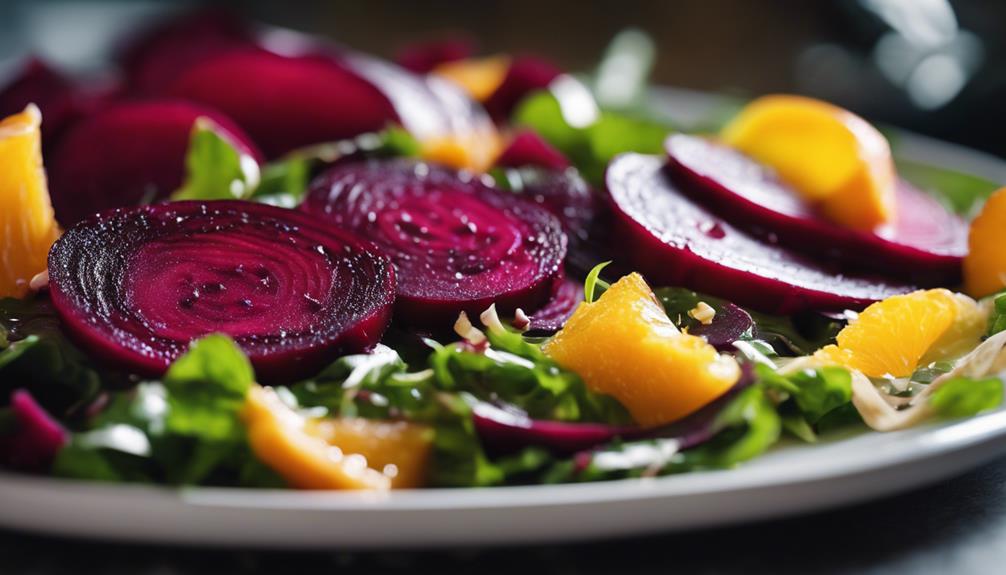
When making a Beet and Citrus Salad, consider the delightful combinations of Beet and Orange Fusion, Beet and Grapefruit Medley, and Beet and Pomegranate Mix. These pairings offer a vibrant mix of flavors and textures that will elevate your salad to a whole new level.
Experimenting with different citrus fruits can bring an invigorating twist to this classic dish.
Beet and Orange Fusion
Explore the vibrant flavors of beet and orange fusion in this invigorating Beet and Citrus Salad. The combination of earthy beets and zesty oranges creates a delightful harmony that's both rejuvenating and satisfying. Here are some reasons why this fusion is a must-try:
- Vibrant Colors: The deep red of the beets paired with the bright orange segments make this salad visually appealing.
- Balanced Sweetness: The natural sweetness of the beets complements the citrusy tang of the oranges perfectly.
- Nutrient Powerhouse: Beets are rich in antioxidants and fiber, while oranges provide a healthy dose of vitamin C.
- Textural Contrast: The tender beets contrast with the juicy oranges, creating a delightful mix of textures.
- Versatile Pairing: The beet and orange fusion can be enhanced with a variety of herbs and dressings to suit your taste preferences.
This Beet and Citrus Salad showcases the beauty of simple ingredients coming together to create a dish that's as nutritious as it's delicious.
Beet and Grapefruit Medley
Indulge in the tantalizing blend of beets and grapefruit in this vibrant Beet and Grapefruit Medley for an invigorating and flavorful salad experience. This delightful medley combines the earthy sweetness of roasted beets with the zesty and rejuvenating flavor of grapefruit, creating a harmonious fusion that will tantalize your taste buds.
Unordered list to grab your attention:
- Roasted beets add a rich and caramelized flavor to the medley.
- Pickled beets provide a contrasting tanginess and a burst of acidity.
- Fresh and juicy grapefruit segments balance the sweetness of the beets.
- A sprinkle of crumbled feta cheese enhances the creamy texture and adds a salty kick.
- Toasted walnuts bring a delightful crunch and nuttiness to the dish.
This Beet and Grapefruit Medley isn't only a feast for the palate but also a visually stunning addition to your table. Whether as a side dish or a light meal on its own, this medley offers a revitalizing and satisfying combination of flavors and textures.
Beet and Pomegranate Mix
Tantalize your taste buds with the vibrant fusion of beets and pomegranate in this invigorating Beet and Citrus Salad. The combination of flavors and textures in this dish will surely captivate your palate. Here are some reasons why you should try this delightful mix:
- Roasted Beet: The earthy sweetness of roasted beets adds a rich depth to the salad, enhancing its overall flavor profile.
- Pickled Beet: The tangy kick from pickled beets provides a contrast that brightens up the dish, creating a harmonious balance of tastes.
- Pomegranate Arils: Bursting with juicy sweetness, pomegranate arils add a revitalizing pop of flavor that complements the beets perfectly.
- Citrus Zest: The zesty citrus undertones elevate the salad, bringing a hint of brightness and acidity to each bite.
- Fresh Herbs: Fragrant fresh herbs like mint or parsley add a burst of invigoration, tying all the elements together for a truly satisfying culinary experience.
Enjoy the explosion of flavors as you savor each mouthful of this Beet and Pomegranate Mix in your Beet and Citrus Salad!
Sous Vide Prep Pointers
When preparing sous vide dishes like the Beet and Citrus Salad, remember these key pointers:
- Pay close attention to time and temperature settings to achieve the desired doneness.
- Experiment with different bagging techniques to guarantee maximum flavor infusion.
- Consider the various cooking vessel options available for your sous vide setup.
These tips will help you master the art of sous vide cooking and elevate your culinary creations to new heights.
Time and Temperature
For precise sous vide cooking, maintaining the correct time and temperature is vital to achieve perfect results in your dishes. Sous vide techniques involve cooking food in vacuum-sealed bags at precise temperatures for extended periods. This method allows for even cooking and flavor infusion, guaranteeing that your ingredients retain their natural taste and nutrients.
Temperature control is essential in sous vide cooking for cooking precision. By setting the water bath to the exact temperature needed for your recipe, you can achieve consistent results every time. Whether you're cooking meats, vegetables, or desserts, the right temperature ensures that your food is cooked to perfection without overcooking or undercooking.
To master sous vide cooking, invest in a reliable sous vide machine that offers precise temperature control. Follow recipes carefully, adjusting cooking times based on the thickness of your ingredients. With attention to time and temperature, you can elevate your dishes to a whole new level of flavor and texture.
Bagging Techniques
Consider vacuum-sealing your ingredients for sous vide cooking to guarantee maximum flavor infusion and uniform cooking results. When you vacuum seal your food, it helps to preserve the natural juices and flavors, which can enhance the overall taste of your dish. This method is particularly effective for ingredients like beets and citrus, as it allows them to marinate in their own juices during the cooking process, resulting in a more intense and concentrated flavor profile.
Using an immersion circulator in conjunction with a water bath ensures that the ingredients are cooked evenly at a precise temperature for an extended period. The vacuum-sealed bags protect the food from direct contact with the water, allowing for a gentle and consistent cooking environment. This technique is ideal for delicate ingredients that require precise temperature control to achieve perfect doneness. By vacuum sealing your ingredients before placing them in the water bath with the immersion circulator, you can achieve restaurant-quality results in the comfort of your own kitchen.
Cooking Vessel Options
To guarantee peak results in your sous vide cooking, select the appropriate cooking vessel based on the size and quantity of ingredients you plan to prepare. For smaller portions or individual servings, using a pot or a large heatproof container is suitable. These vessels allow for precise temperature control and even cooking. If you're planning to cook larger quantities or bigger cuts of meat, consider using a dedicated sous vide water bath or a container with a lid to minimize water evaporation over longer cooking times.
When choosing a cooking vessel, keep in mind that the sous vide method is different from pressure cooking or slow roasting. While pressure cooking uses high pressure to cook food quickly, sous vide relies on precise temperature control for extended periods. Slow roasting, on the other hand, involves cooking at low temperatures in an oven over several hours. The sous vide technique requires a water bath to circulate and maintain a consistent temperature, ensuring your ingredients are cooked perfectly every time.
Final Thoughts
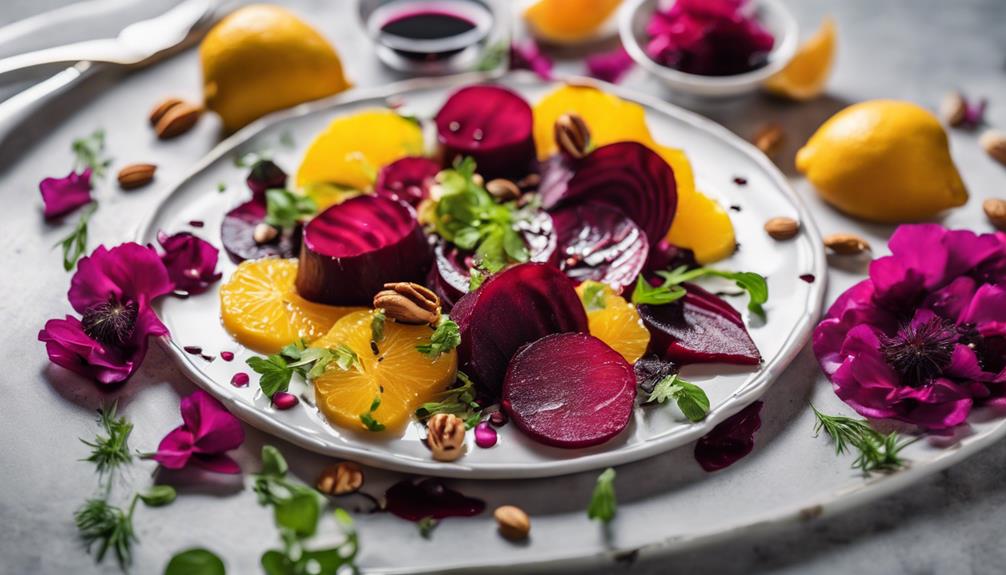
Wrapping up your culinary journey with this sous vide beet and citrus salad, reflect on the invigorating blend of flavors and textures you've experienced. The earthy sweetness of the beets, the zesty brightness of the citrus, and the nuttiness of the arugula all come together to create a symphony of tastes on your palate. The tender, perfectly cooked beets provide a satisfying contrast to the juicy bursts of citrus with each bite.
As you ponder on the flavors, consider serving this vibrant salad as an elegant starter for a dinner party or a revitalizing side dish for a summer picnic. The colorful presentation and the delicate balance of ingredients make it a versatile dish that complements a variety of main courses. For a touch of added richness, you might sprinkle some feta cheese or toasted nuts on top before serving. Alternatively, keep it light and fresh by drizzling a simple vinaigrette over the salad just before enjoying it. Experiment with different plating styles to elevate the visual appeal of this delightful sous vide creation.
Frequently Asked Questions
Can I Use Other Vegetables Besides Beets in the Salad?
You can definitely use different vegetables in the salad to explore unique flavor combinations. Experiment with options like carrots, radishes, or sweet potatoes to add variety and depth to your dish. Have fun mixing and matching!
How Long Will the Salad Stay Fresh in the Fridge?
To keep your salad fresh in the fridge, store it in an airtight container. Check for any wilting or discoloration as freshness indicators. It will typically stay good for 3-5 days. Consider adding dressing just before serving to preserve crispness.
Can I Substitute the Citrus in the Salad With Another Fruit?
You can definitely substitute the citrus in the salad with another fruit. There are various fruit alternatives like berries, apples, or pomegranate seeds that can work well. Get creative with flavor combinations and ingredient swaps!
Is It Necessary to Peel the Beets Before Cooking Sous Vide?
You should peel beets before cooking sous vide. Beet skins can impact flavor and texture. Removing them guarantees a smoother, more consistent result. Enjoy the vibrant colors and flavors that shine through in your dish.
Can I Use a Different Type of Vinegar in the Salad Dressing?
You can definitely experiment with different vinegar options for the dressing. This simple swap can lead to exciting flavor variations based on your taste preferences. Try out alternatives to find the perfect balance for your salad.
Conclusion
To sum up, sous vide cooking offers a unique way to enhance the flavors and textures of beets in this citrus salad. By using precise temperature control, you can lock in the natural sweetness and nutrients of the beets while infusing them with the bright, tangy flavors of citrus.
Experiment with different varieties of beets and citrus fruits to create your own delicious and nutritious sous vide beet and citrus salad at home. Enjoy exploring the ancient culinary roots of this vibrant dish!
